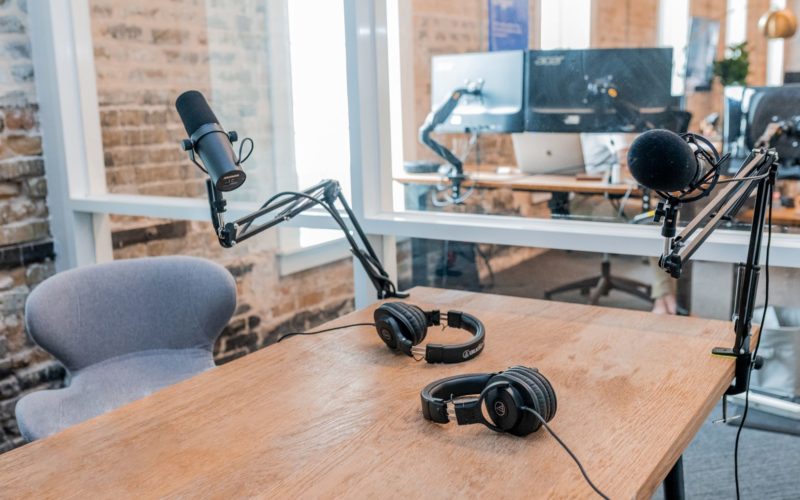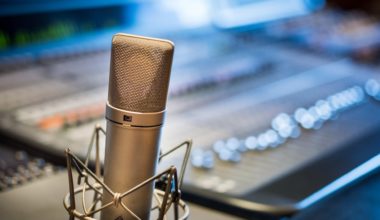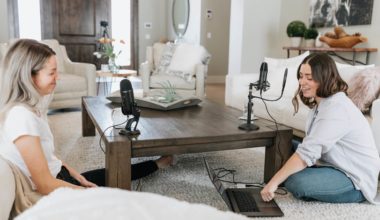Bad audio quality is the number one reason people stop listening to a podcast. It doesn’t matter if you are dropping priceless nuggets of wisdom on your show, if it sounds bad no one will care. You want your podcast to sound amazing? Here are some general pointers on how to do so.
1. Get the distance right
When you speak too close to the microphone, the lower frequencies will be enhanced. Your voice will sound too bass-y which is more of an issue for male podcasters. This is called the proximity effect. When you are too close to the mic, it will also pick up many unwanted noises like lips smacking, your breathing, etc. You can overcome this problem by keeping your distance. The best distance is between 6 to 8 inches from the microphone.
If you are too far off from the mic, the recording will sound distant and reverb-y, especially if the room where you are recording your podcast in isn’t treated properly. Which brings us to the next point:
2. Control the acoustics of your recording space.
You can reduce echo and reverberation by making your recording space sound as “dead” as possible. Deadening the room can be achieved by placing sound-absorbing panels and foam on the walls and a heavy carpet on the floor. This can be costly but is necessary if you want to achieve high-quality audio. You can also use cheaper materials like blankets and pillows. As always, there are DIY alternatives to professional equipment. Just do a google search for “DIY sound treatment”.
If you are a solo podcaster, closets are a popular makeshift recording studio. It’s much easier to control the acoustics of a small space than a large one. Closets usually have lots of clothes already which help dampen the sound. Just remember that soft and squishy is good and flat and hard is bad.
3. Use pop filters
Pop filters are great for preventing plosives (popping sounds). These are the sounds that you hear when a speaker says the letter P or B. These sounds are not only very unpleasant but also create distortion in your podcast. You can buy pop filters online or make your own out of stockings or old socks. There are many tutorials on Youtube on how to make pop filters.
A windscreen can also be used to prevent plosives. This is a small foam cover that attaches to the end of your microphone. But remember that a very thick windscreen might change the timbre of your voice by cutting out the higher frequencies. If you want to make the most out of your microphone’s capabilities, a pop filter is a better option.
4. Get a shock mount.
Let’s say you are recording your podcast and you accidentally hit your elbow on the desk and it makes a huge thud. You can fix this with a shock mount. A shock-mount suspends the microphone in mid-air, held together by a system of elastic bands. If you make a sudden move with your arm, the shockwave will not be transferred to the mic, and you won’t get that thud. It’s a pretty simple and cheap fix, but it can really save your show – especially if you have a particularly fidgety guest on your podcast.
Some expensive mics have pop filters and shock mounts built-in.
5. Hydrate
If your mouth is dry, your words will sound harsh and unnatural. Make sure to drink a lot of water before you record. Your recording will sound better when you’re hydrated. Keep a glass of water by you while recording. I’ve heard apple juice works well too, but I haven’t tried it. Avoid sippers as the straw will likely make a lot of noise.
6. Know your microphone
This may seem obvious, but knowing the characteristics of your microphone is key. Not all mics are the same. Different microphones have different pickup patterns, some are omnidirectional, others are cardioid, and some are bidirectional. Each one has its own sweet spot.
I remember reading about a guy complaining on some internet forum about the poor quality sound he was getting from his expensive microphone. It was revealed in his replies that he was using a side-address microphone but he was talking straight into it, instead of talking into the side.
7. Always use headphones while recording
Picture this: You just finished recording your podcast. It was informative, you were funny. Then you listen back to it. Wait, what is that clicking noise in the background? Why are you sounding so quiet? And your co-host, why is she so loud?
How did you end up with an uneven audio track? But how did you not notice it? You weren’t monitoring it. It’s so much easier to figure out what the problem is during recording and eliminating it in the first place than trying to fix it in post.
Monitor the audio at all times, and I mean all times. The golden rule of recording podcasts: ABM (Always Be Monitoring).








